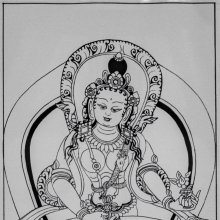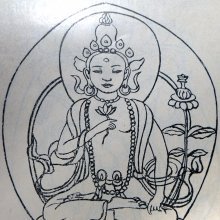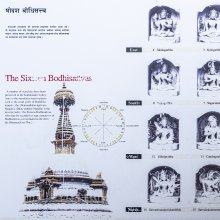Amitaprabha: 6 definitions
Introduction:
Amitaprabha means something in Buddhism, Pali, Hinduism, Sanskrit. If you want to know the exact meaning, history, etymology or English translation of this term then check out the descriptions on this page. Add your comment or reference to a book if you want to contribute to this summary article.
Images (photo gallery)
In Buddhism
Tibetan Buddhism (Vajrayana or tantric Buddhism)
Source: Wisdom Library: MañjuśrīnāmasaṃgītiAmitaprabha (अमितप्रभ) is one of the sixteen bodhisattvas appearing in the Vajradhātu-mahāmaṇḍala, according to the Nāmamantrārthāvalokinī v5.38-41. The Nāmamantrārthāvalokinī (literally, ‘an explanation of the nāma-mantras’) is a commentary (ṭīkā) on the 8th century Mañjuśrīnāmasaṃgīti.
Amitaprabha is a name of Mañjuśrī (the embodiement of non-dual knowledge) and, together with other names, forms the core essence of the Mañjuśrīnāmasaṃgīti. The Nāmamantrārthāvalokinī provides the practitioner a sādhana (‘meditative practice’) to turn these names into mantras. These mantras are chanted for the benefit of all beings, and then placed and contemplated in the Vajradhātu-mahāmaṇḍala, which is an extended version of the Vajradhātu-maṇḍala.
Source: archive.org: The Indian Buddhist IconographyAmitaprabha (अमितप्रभ) (“boundless light”) is the name of a Bodhisattva commonly depicted in Buddhist Iconography, and mentioned in the 11th-century Niṣpannayogāvalī of Mahāpaṇḍita Abhayākara.—his color is white or red; his symbol is the jar. Amitaprabha is also known as Amṛtaprabha. It appears that Amitaprabha should belong to the family of Vairocana because of his white colour. His spiritual father will be Amitabha when he is red in colour.
Amitaprabha is described in the Niṣpannayogāvalī as follows:—
Source: Brill: Śaivism and the Tantric Traditions (tantric Buddhism)(1: Mañjuvajra-maṇḍala):—“Amitaprabha is of red colour and holds in his two hands the jar required in the bath of initiation”. (2: Dharmadhatūvāgīśvara-maṇḍala):—“Amitaprabha is of white colour. With the right hand he holds the double lotus and with the left hand a jar on lotus”.
Amitaprabha (अमितप्रभ) refers to one of the sixteen Bodhisattvas, according to the Nāmamantrārthāvalokinī and Abhayākaragupta’s forty-three deity Mañjuvajra-maṇḍala (Tricatvāriṃśadātmakamañjuvajra-maṇḍala: see Niṣpannayogāvalī 50).—A set of sixteen Bodhisattvas often supplements the deities of the Tattvasaṃgraha in later Vajradhātu-maṇḍala descriptions. These are generally the sixteen Bodhisattvas of the present aeon (bhadrakalpa) [e.g., Amitaprabha], as described for example in Abhayākaragupta’s Niṣpannayogāvalī Vajradhātu-maṇḍala.—Cf. also Niṣpannayogāvalī 44ff and Abhayākaragupta’s Durgatipariśodhana-maṇḍala (Cf. Niṣpannayogāvalī 66ff).

Tibetan Buddhism includes schools such as Nyingma, Kadampa, Kagyu and Gelug. Their primary canon of literature is divided in two broad categories: The Kangyur, which consists of Buddha’s words, and the Tengyur, which includes commentaries from various sources. Esotericism and tantra techniques (vajrayāna) are collected indepently.
Languages of India and abroad
Sanskrit dictionary
Source: Cologne Digital Sanskrit Dictionaries: Edgerton Buddhist Hybrid Sanskrit DictionaryAmitaprabha (अमितप्रभ).—(1) another name for Amitābha: Sukhāvatīvyūha 50.6 (verse); 53.15 (verse); 62.13—14 (prose), here one of three names for the same personage, Amitābham Amita- prabham Amitāyuṣaṃ (tathāgatam etc.); (2) name of a different (future) Buddha: Sukhāvatīvyūha 70.6.
Source: Cologne Digital Sanskrit Dictionaries: Aufrecht Catalogus CatalogorumAmitaprabha (अमितप्रभ) as mentioned in Aufrecht’s Catalogus Catalogorum:—Yogaśatabhāṣya med. Io. 2357. Np. Ix, 64.
Source: Cologne Digital Sanskrit Dictionaries: Monier-Williams Sanskrit-English DictionaryAmitaprabha (अमितप्रभ):—[=a-mita-prabha] [from a-mita] m. (= amitābha), [Sukhāvatī-vyūha ii]
Sanskrit, also spelled संस्कृतम् (saṃskṛtam), is an ancient language of India commonly seen as the grandmother of the Indo-European language family (even English!). Closely allied with Prakrit and Pali, Sanskrit is more exhaustive in both grammar and terms and has the most extensive collection of literature in the world, greatly surpassing its sister-languages Greek and Latin.
See also (Relevant definitions)
Partial matches: Amita, Prabha.
Starts with: Amitaprabhasa, Amitaprabhava.
Full-text: Bodhisattva, Yogashata, Amitabha, Amritaprabha, Yogashataka.
Relevant text
Search found 3 books and stories containing Amitaprabha, Amita-prabha; (plurals include: Amitaprabhas, prabhas). You can also click to the full overview containing English textual excerpts. Below are direct links for the most relevant articles:
The Indian Buddhist Iconography (by Benoytosh Bhattachacharyya)
The Larger Sukhavativyuha Sutra
Trishashti Shalaka Purusha Caritra (by Helen M. Johnson)
Part 4: War between Kṛṣṇa and Jarāsandha < [Chapter VII - Marriages of Śāmba and Pradyumna]



